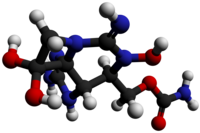Neosaxitoxin
 |
|
 |
|
| Names | |
|---|---|
|
IUPAC name
[(3aS,4R,10aS)-5,10,10-Trihydroxy-2,6-diiminooctahydro-1H,8H-pyrrolo[1,2-c]purin-4-yl]methyl carbamate
|
|
| Other names
1H,10H-Pyrrolo(1,2-c)purine-10,10-diol, 2-amino-4-(((aminocarbonyl)oxy)methyl)-3a,4,5,6,8,9-hexahydro-5-hydroxy-6-imino-, (3aS,4R,10aS)-; 1H,10H-Pyrrolo(1,2-c)purine-10,10-diol, 2-amino-4-((aminocarbonyl)oxy)methyl-3a,4,5,6,8,9-hexahydro-5-hydroxy-6-imino-,(3aS,4R,10aS)-; 1H,10H-Pyrrolo(1,2-c)purine-10,10-diol, 2-amino-4-((aminocarbonyl)oxy)methyl-3a,4,5,6,8,9-hexahydro-5-hydroxy-6-imino-,(3aS-(3aalpha,4alpha,10aR*))-
|
|
| Identifiers | |
|
3D model (JSmol)
|
|
| ChemSpider | |
|
|
|
|
| Properties | |
| C10H17N7O5 | |
| Molar mass | 315.286 |
|
Except where otherwise noted, data are given for materials in their standard state (at 25 °C [77 °F], 100 kPa).
|
|
| Infobox references | |
Neosaxitoxin (NSTX) is included, as other saxitoxin-analogs, in a broad group of natural neurotoxic alkaloids, commonly known as the paralytic shellfish toxins (PSTs). The parent compound of PSTs, saxitoxin (STX), is a tricyclic perhydropurine alkaloid, which can be substituted at various positions, leading to more than 30 naturally occurring STX analogues. All of them are related imidazoline guanidinium derivatives.
NSTX, and other PSTs, are produced by several species of marine dinoflagellates (eukaryotes) and freshwater cyanobacteria, blue-green algae (prokaryotes), which can form extensive blooms around the world. Under special conditions, during harmful algal blooms (HAB) or red tide, all these toxins may build up in filter-feeding shellfish, such as mussels, clams and oysters, and can produce an outbreak of Paralytic Shellfish Poisoning (PSP).
Saxitoxin analogues associated to PSP can be divided into three categories:
NSTX is quite similar to saxitoxin, like all the neurotoxins associated to PSP, the only difference is that NSTX shows one hydroxyl group bonded to nitrogen "1", where saxitoxyn contains one hydrogen (that hydroxyl group is in the red circle of the image).
This purine is highly hydrophilic and thermostable, it is not destroyed by cooking. Moreover, is very stable in usual storage, specially in acidic condition.
NSTX blocks the extracellular portion, the outer vestibule, of some voltage gated sodium channels in a very powerful and reversible manner, without affection of other ion channels.
"Voltage gated", also called "voltage sensitive" and "voltage dependant" sodium channel also known as "VGSCs" or "Nav channel" are crucial elements of normal physiology in a variety of animals, including flies, leeches, squid and jellyfish, as well as mammalian and non-mammalian vertebrates. This large integral membrane protein plays an essential role in the initiation and propagation of action potentials in neurons, myocytes and other excitable cells.
Nav channels form the basis for electrical excitability in animals. Nav channels evolved from Ca2+ channels and were present in the common ancestor of choanoflagellates and animals, although this channel was likely permeable to both Na+ and Ca2+. Thus, like many other neuronal channels and receptors, Nav channels predated neurons. Invertebrates possess two Nav channels (Nav1 and Nav2), whereas vertebrate Nav channels are of the Nav1 family.
...
Wikipedia
